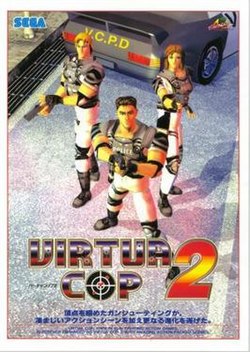
Virtua Fighter is a fighting game created for the Sega Model 1 arcade platform by AM2, a development group within Sega, headed by Yu Suzuki. An early prototype version was location tested in Japan by August 1993, before the complete game was released worldwide in December 1993. It is the first game in the Virtua Fighter series, and the first arcade fighting game to feature fully 3D polygon graphics. The game has been ported to several platforms including the Sega Saturn, Sega 32X, and Microsoft Windows.

Area 51 is a light gun arcade game released by Atari Games in 1995. It takes its name from the military facility. The plot of the game involves the player taking part in a Strategic Tactical Advanced Alien Response (STAAR) military incursion to prevent aliens, known as the Kronn, and alien-created zombies from taking over the Area 51 military facility.

Virtua Cop is a 1994 light gun shooter game developed by Sega AM2 and designed by Yu Suzuki. It was originally an arcade game on the Sega Model 2 system, and was ported to the Sega Saturn in 1995 and Windows in 1996. The Saturn version included support for both the Virtua Gun and Saturn mouse, as well as a new "Training Mode" which consists of a randomly generated shooting gallery.

Daytona USA is an arcade racing game developed by Sega AM2 and released by Sega in March of 1994. Inspired by the popularity of the NASCAR motor racing series in the US, the game has players race stock cars on one of three courses. It was the first game to be released on the Sega Model 2 arcade system board. Daytona USA is one of the highest-grossing arcade games of all time.

Virtua Racing or V.R. for short, is a Formula One racing video game developed by Sega AM2 and released for arcades in 1992. Virtua Racing was initially a proof-of-concept application for exercising a new 3D graphics platform under development, the "Model 1". The results were so encouraging that Virtua Racing was fully developed into a standalone arcade title.

Sega AM Research & Development No. 2, previously known as SEGA-AM2 Co., Ltd., is a video game development team within the Japanese multinational video game developer Sega. Yu Suzuki, who had previously developed arcade games for Sega including Hang-On and Out Run, was the first manager of the department.
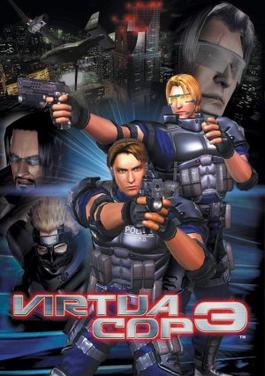
Virtua Cop 3 is the third and final game installment from Sega's Virtua Cop light gun shooter franchise, and released exclusively for video arcades in 2003. The game is available in standard and deluxe cabinet formats and runs on Sega Chihiro arcade hardware. A port for the Xbox was planned, but later cancelled.
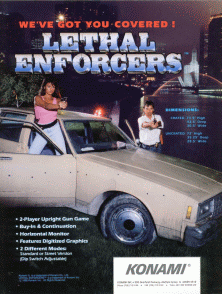
Lethal Enforcers is a 1992 light gun shooter released as an arcade video game by Konami. The graphics consist entirely of digitized photographs and digitized sprites. Home versions were released for the Super NES, Genesis and Sega CD during the following year and include a revolver-shaped light gun known as The Justifier.
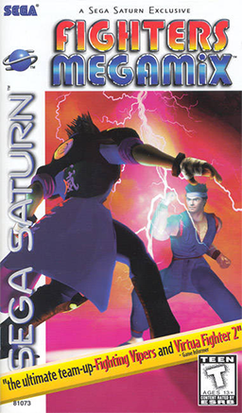
Fighters Megamix is a 1996 fighting game developed by Sega AM2 for the Sega Saturn. It is a crossover between Sega's 3D arcade fighting games Virtua Fighter 2 and Fighting Vipers, with unlockable characters from several other AM2 games such as Virtua Cop 2 and Daytona USA. It allows gamers to play as the bosses of both Virtua Fighter 2 and Fighting Vipers without codes.

Die Hard Arcade, known as Dynamite Deka in Japan, is an arcade beat 'em up video game released by Sega. It was the first beat 'em up to use texture-mapped 3D polygon graphics, and used a sophisticated move set by contemporary beat 'em up standards, often being likened to a fighting game in this respect. It also features quick time events, the ability to combine items to make more powerful weapons, and in two-player mode the ability to perform combined special moves and combos.

Virtua Fighter 2 is a 1994 fighting video game developed by Sega. It is the sequel to Virtua Fighter (1993), and the second game in the Virtua Fighter series. It was created by Sega's Yu Suzuki-headed AM2 and was released for arcades in 1994. Ports were released for the Sega Saturn in 1995 and Microsoft Windows in 1997.
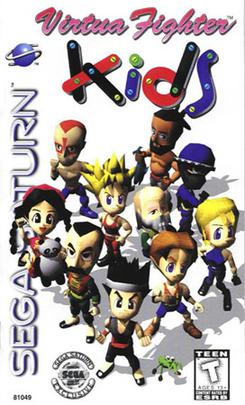
Virtua Fighter Kids is an installment in the Sega AM2 Virtua Fighter fighting game series. A super deformed version of Virtua Fighter 2, it was released in the arcade and on the Sega Saturn in 1996. Unlike Virtua Fighter 2, it was developed on the ST-V board.
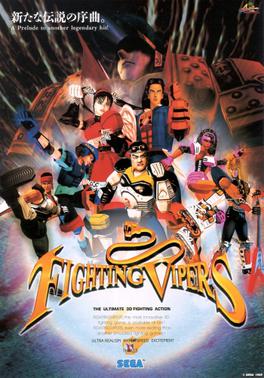
Fighting Vipers is a 3D fighting video game developed by Sega AM2. It uses the same game engine as AM2's Virtua Fighter 2 but features enclosed arenas and an armor mechanic, and was targeted more towards Western audiences, using a U.S. setting and more freeform styles of martial arts. The game was released in the arcade in 1995 using the Sega Model 2 hardware. The game was ported to the Sega Saturn, and to PlayStation Network and Xbox Live Arcade in 2012. Though Fighting Vipers was not very popular in North American arcades, the Saturn version was one of the most high-profile games in the system's 1996 holiday lineup, and was met with positive reviews.

Virtua Fighter 3 is the sequel to 1994's Virtua Fighter 2 and the third fighting game in the Virtua Fighter series, developed by Sega AM2 and published by Sega in 1996. It was the first arcade game to run on the Sega Model 3 system board.

The Lost World: Jurassic Park is a light gun arcade game from Sega. It was released in 1997, and is based on the film of the same name. It is also a sequel to Sega's 1994 Jurassic Park arcade game. A third Jurassic Park arcade game, based on Jurassic Park III, was made by Konami in 2001.
Virtua Fighter is a series of fighting games created by Sega AM2 and designer Yu Suzuki. The original Virtua Fighter was released in December 1993 and has received four main sequels and several spin-offs. The highly influential first Virtua Fighter game is widely recognized as the first 3D fighting game released.

Scud Race is an arcade racing video game released by Sega in 1996. It is the first racing game to use the Sega Model 3 hardware. Despite being released well within the lifetime of the Sega Saturn, no Saturn port was ever released. A Dreamcast port was announced for the system's 1998 launch lineup and was shown as a tech-demo in the Dreamcast Presentation in 1998, but was cancelled.
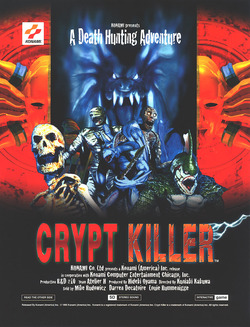
Crypt Killer is a 1995 arcade video game produced by Konami. It was also released in 1997 for the Sega Saturn and Sony PlayStation home consoles, and in Japan for Microsoft Windows. The Saturn version makes use of the Saturn's various light guns, while the PlayStation version is compatible with the Naki Lunar Gun and the Konami Justifier. The game's scenery and characters are all 3D polygon models, while most of the enemies and their projectiles are 2D sprites.

DecAthlete, released in Europe as Athlete Kings due to a licensing issue, is a track-and-field themed arcade sports video game. On its unveiling, the gaming media generally described it as a modern clone of Daley Thompson's Decathlon. Released in 1996, it was developed by Sega AM3 and produced by Sega. A home port was released on the Sega Saturn in 1996, largely identical to the arcade version, due to the similar hardware of the ST-V hardware and the Saturn. It was released on the PlayStation 2 in Japan only as part of the Sega Ages 2500 series. Compared to other decathlon based games, Decathlete has a more comic and cartoon-like style. A sequel followed in 1997, which was the winter sports-based Winter Heat.
Sky Target is a 1995 arcade game by Sega. A rail shooter featuring a number of planes including the default F-14D Super Tomcat, it is best remembered for its semi-official connection to Sega's earlier hit After Burner. Although never billed as a sequel, its overt similarities to the 1987 classic were nonetheless referenced in official promotional materials and recognized by the media. Plus, it features a revised version of the "After Burner" music theme within its soundtrack.
